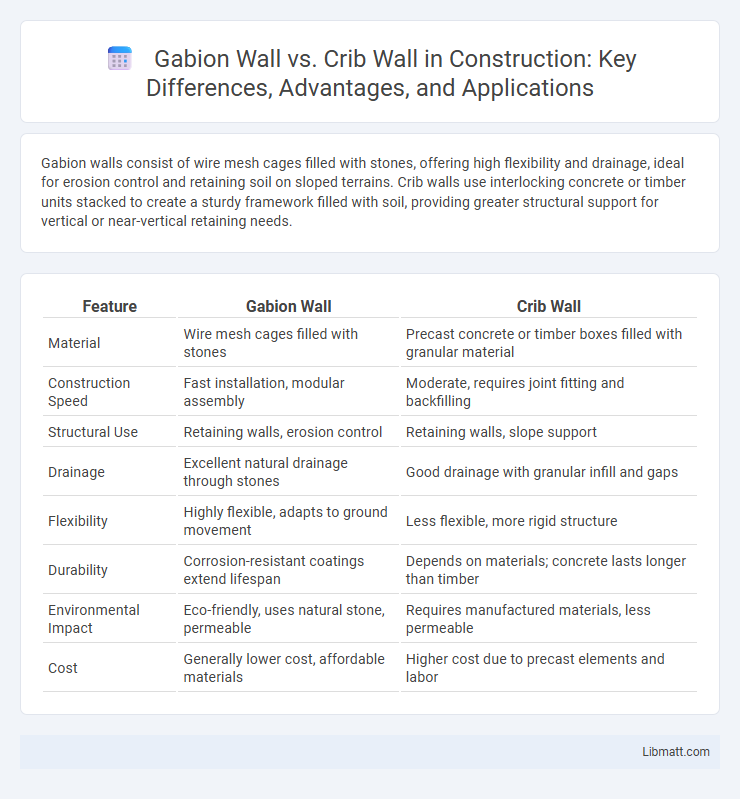Gabion walls consist of wire mesh cages filled with stones, offering high flexibility and drainage, ideal for erosion control and retaining soil on sloped terrains. Crib walls use interlocking concrete or timber units stacked to create a sturdy framework filled with soil, providing greater structural support for vertical or near-vertical retaining needs.
Table of Comparison
| Feature | Gabion Wall | Crib Wall |
|---|---|---|
| Material | Wire mesh cages filled with stones | Precast concrete or timber boxes filled with granular material |
| Construction Speed | Fast installation, modular assembly | Moderate, requires joint fitting and backfilling |
| Structural Use | Retaining walls, erosion control | Retaining walls, slope support |
| Drainage | Excellent natural drainage through stones | Good drainage with granular infill and gaps |
| Flexibility | Highly flexible, adapts to ground movement | Less flexible, more rigid structure |
| Durability | Corrosion-resistant coatings extend lifespan | Depends on materials; concrete lasts longer than timber |
| Environmental Impact | Eco-friendly, uses natural stone, permeable | Requires manufactured materials, less permeable |
| Cost | Generally lower cost, affordable materials | Higher cost due to precast elements and labor |
Introduction to Gabion Walls and Crib Walls
Gabion walls consist of wire mesh containers filled with rocks or stones, providing durable and permeable retaining structures ideal for erosion control and landscaping. Crib walls are modular, gravity-retaining systems made from interlocking timber, concrete, or steel components, offering flexibility in height and layout adjustments. Both types effectively stabilize slopes but differ in materials, construction techniques, and environmental impact.
Structural Design Differences
Gabion walls consist of wire mesh cages filled with rocks, providing flexibility and permeability that adapt well to ground movement and water drainage. Crib walls feature interlocking precast concrete or timber boxes stacked horizontally, creating a rigid structure designed for high load-bearing capacity and stability. The structural design of gabion walls emphasizes energy dissipation and deformation tolerance, whereas crib walls rely on mechanical interlock and mass for resisting lateral earth pressures.
Materials Used in Gabion vs Crib Walls
Gabion walls are constructed using wire mesh cages filled with rocks or stones, providing excellent drainage and flexibility in retaining structures. Crib walls consist of interlocking precast concrete or timber boxes that are filled with soil or granular material, offering structural stability and ease of installation. The choice between gabion and crib wall materials impacts durability, environmental compatibility, and suitability for different soil conditions in retaining wall projects.
Installation and Construction Process
Gabion walls consist of wire mesh cages filled with stones, enabling quick assembly by stacking and securing the cages together, often requiring minimal specialized labor. Crib walls involve constructing a framework of timber or precast concrete boxes that are filled with granular material, demanding precise alignment and more complex formwork during installation. The gabion system typically allows for faster installation with greater flexibility on uneven terrain, whereas crib walls provide enhanced structural rigidity but require longer construction time and more intensive site preparation.
Cost Comparison
Gabion walls generally have lower material costs due to the use of wire mesh cages filled with readily available stones, whereas crib walls require more expensive prefabricated concrete or timber components. Installation expenses are typically higher for crib walls because of the need for skilled labor and heavier machinery, compared to the simpler assembly process involved in gabion wall construction. Overall, gabion walls offer a more cost-effective solution for erosion control and retaining structures, especially in terrain with abundant local stone resources.
Durability and Longevity
Gabion walls, constructed with galvanized steel mesh filled with stones, offer exceptional durability against weathering, erosion, and seismic activity, ensuring a lifespan of several decades with minimal maintenance. Crib walls, typically made from timber or concrete, provide good structural support but are more susceptible to rot, insect damage, and environmental wear, which can reduce their longevity compared to gabion systems. Investing in gabion walls is a strategic choice for projects requiring long-term stability and resilience in challenging environmental conditions.
Aesthetic Appeal and Landscape Integration
Gabion walls offer a natural, rugged aesthetic with their stone-filled wire baskets that blend seamlessly into outdoor environments, making them ideal for enhancing rustic or eco-friendly landscapes. Crib walls feature a more structured, geometric appearance using timber or concrete grids that provide a modern, engineered look suitable for urban or contemporary settings. Your choice depends on whether you prefer the organic, textured integration of a gabion wall or the clean, modular design of a crib wall to complement your landscape's style.
Environmental Impact and Sustainability
Gabion walls use wire mesh cages filled with stone, promoting natural drainage and enabling vegetation to grow through the gaps, which enhances habitat connectivity and reduces runoff pollution. Crib walls, constructed from interlocking modular concrete units, offer durability but often involve higher embodied carbon due to concrete production and less permeability, potentially disrupting natural water flow. Both systems can contribute to slope stabilization, but gabion walls generally provide greater environmental benefits through sustainable material use and improved ecological integration.
Applications and Best Use Cases
Gabion walls are ideal for erosion control, slope stabilization, and riverbank protection due to their permeability and flexibility in harsh environments. Crib walls excel in retaining soil for landscaping, roadways, and bridge abutments where structural strength and aesthetic appeal are important. Both systems are commonly used in civil engineering but are selected based on site conditions, load requirements, and environmental impact.
Maintenance Requirements and Lifespan
Gabion walls require minimal maintenance due to their durable wire mesh and natural stone infill, which resist weathering and erosion, typically lasting 50 years or more. Crib walls, constructed from timber or precast concrete, often need more frequent inspections and repairs, especially timber cribs prone to rot and insect damage, resulting in a shorter lifespan of 20 to 40 years. Your choice should consider that gabion walls offer greater longevity with less upkeep compared to the more maintenance-intensive crib walls.
Gabion wall vs crib wall Infographic

 libmatt.com
libmatt.com